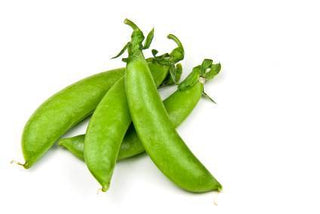(Pisum sativum var. macrocarpon)
As one of the earliest vegetables available after the winter months, sugarsnap peas are a sure sign of spring. Easy to grow, nutritious and tasty, sugarsnap peas are a great choice for moms and kids seeking healthy snacks and meal options.
Legume Family
Like all green peas, sugarsnap peas are members of the legume family. This family includes plants that bear pods enclosing fleshy seeds. Well-known legumes include peas, beans, lentils, soy and peanuts. Legume pods are edible (snow peas, sugarsnap peas), non-edible (soybeans, peanuts) or discarded for their peas inside (green peas).
Snow peas (Chinese pea pods) have flat, tender pods with small, undeveloped peas inside whereas sugarsnap peas have crunchy, delicious plump pods with sweet full-sized peas inside. Sugarsnap peas were developed by crossing Chinese snow peas with a mutant shell pea plant.
Peas and other legumes benefit from bacteria (rhizobia) that live in nodules along their roots. These bacteria draw nitrogen from the soil and affix it into a form that the plant uses as a nutrient. The nitrogen fixation ability of legumes allows these plants to be used in crop rotation to replenish the soil depleted of nitrogen. It also increases the protein content of legumes in comparison to non-legume vegetables.
Nutritionally Satisfying
Sugarsnap peas are nutritious and satisfying. Sugarsnap peas have a low Glycemic Index and as a food that is mildly anti-inflammatory, they are a good choice for those following an Anti-Inflammatory Diet.
One cup of raw sugarsnap peas is just 41 calories. Even though sugarsnap peas provide mostly carbohydrates (73%) almost half is from fiber.
Like other legumes, sugarsnap peas are a good source of protein (23%) but contain low quantities of the essential amino acid methionine. In many cultures, legumes are often combined with grains. Grains are low in the essential amino acid lysine, which legumes contain. By combining these complementary foods, a complete essential amino acid profile can be obtained – an important consideration for vegetarians.
Sugarsnap peas are a very good source of vitamin A, vitamin C, vitamin K, thiamin, folate, iron and manganese. They are also a good source of riboflavin, vitamin B6, pantothenic acid, magnesium, phosphorous and potassium.
Fresh is Best
While sugarsnap peas are available all year long, they are best in the spring and the fall. They can be purchased at grocery stores and farmer's markets but they are best when fresh. When selecting, make sure they are a good green color. Avoid all peas that have dark spots on the pod. The best snap peas are firm with a velvety feeling on the outside.
Once selected, make sure to refrigerate the peas to keep them fresh. Most of the sugar content in the peas turns to starch if they are left out too long. It is best to wash the peas during preparation and not before storing.
Preparing Snap Peas
Sugarsnap peas have "strings" much like the ones on celery. To remove them, pinch one tip of the pea to get hold of the string. Pull it up the straight side toward the stem end, and then pinch it off.
When preparing for consumption, rinse the snap peas. The shell itself is a great source of vitamins and minerals and does not need to be removed. You can shell the snap peas to eat the peas themselves. To do so, remove the shell and rinse the peas.
Snap peas are great to eat as a sweet, crunchy snack. They can be eaten raw, steamed, sautéed or stir-fried. Steam or stir-fry sugar snap peas for just three minutes so they retain their crispness and flavor.
One of the best ways to eat sugarsnap peas is in a salad. One of our favorites is Baby Lettuce with Sugarsnap Peas, Avocado & Shrimp.

